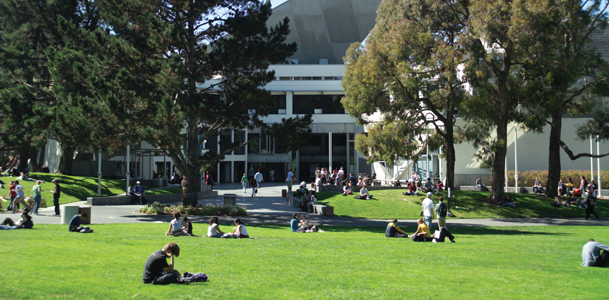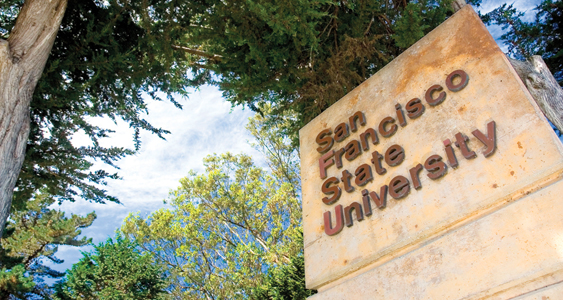For the administration, faculty and student body at San Francisco State University (SFSU), sustainability isn’t some far-off goal.

The university boasts impressive recycling and composting programs. Next to every trash bin on campus, you’ll find a recycling bin and, in most cases, a compost bin. Single-stream recycling bins make it easier to be green by allowing students and faculty to toss any recyclable item into the same blue bin, rather than having to separate paper, glass and plastic.
By Bill Picture
Published: August, 2010
In 2007, when university president Robert A. Corrigan signed the American College & University Presidents’ Climate Commitment (ACUPCC), thereby pledging to make institutional changes that would reduce SFSU’s carbon footprint and promote similarly green research and education efforts, the school already boasted an impressive number of eco-minded programs and studies that made sustainability a key component of campus culture. The changes that followed further minimized SFSU’s impact on its host planet, and, just a few months ago, earned it a spot on The Princeton Review and U.S. Green Building Council’s list of the country’s most environmentally responsible colleges.
Since the 1970s, when the notion of environmental stewardship first firmly took root, SFSU has been actively searching for ways to be green. For instance, long before the ever-present green bin became a fixture in Bay Area homes and businesses, the university was collecting all of its yard waste for composting.
Then, recognizing that coming up with better ways for its staff and 31,000-plus students to get to and from the campus (as well as around it) presented a major opportunity for the university to “spare the air,” the school began offering free shuttle bus service to and from the nearest BART station. Parking fees were also increased and the number of parking spaces reduced, with the aim of encouraging people to bus, bike, walk and skate to school each day. Bike parking was also increased, bike paths were installed to connect the 141-acre campus to surrounding city-maintained bike routes, and valet bicycle parking became available.
Those efforts—along with, among other things, ever-increasing energy efficiency, expanded composting, an aggressive recycling program, an increase in student housing, and purchasing policies that favor energy-efficient equipment and recycled products—paid off in a big way. By the time SFSU released its Climate Action Plan in May of this year (that plan addressed the findings of a greenhouse gas inventory that preceded it in 2008), the university had already exceeded the initial goal set by the Intergovernmental Panel on Climate Change (IPCC), the leading body on the assessment of climate change. That goal called for a 25 percent reduction in carbon emissions below 1990 levels by 2020. SFSU’s carbon emissions are currently 5 percent under 1990 levels.
“The next goal is a 40 percent reduction below 1990 levels by 2030,” said Campus Sustainability Programs Manager Caitlin Steele. “And we’re really committed to that. We really want to push things forward, and be a leader.”
Step away from the car
SFSU’s 2008 Greenhouse Gas Inventory showed that, despite previously mentioned efforts, vehicle emissions remain the institution’s single largest source of emissions, with all but about 1 percent attributable to commuting. Thus, the Climate Action Plan that followed, which was drafted by the University Sustainability Committee created after President Corrigan signed the ACUPCC, includes a hefty section with ideas for further reducing commuter-related emissions.
Those ideas include creating a Universal Transit Pass Program for students, improving the participation rate in the existing ride share program, promoting and expanding the on-campus Zipcar program, possibly expanding bike valet hours and installing cross-campus bike paths (it is currently against SFSU rules to ride bikes on campus), and installing even more bike racks. There’s even talk of attempting to secure funding for a “guaranteed ride home” program.
The cross-campus bike paths are already in the works. In fact, the north-south path will be completed this year. Those paths were included as a part of a Campus Master Plan created in 2007. The focus of that plan was to develop a more sustainable campus, and one that is better connected to surrounding communities.
It is largely the duty of the newly-created University Transportation Committee to investigate the other ideas, and determine their feasibility. The goal is to reduce commuter-related emissions by at least another 5 percent by 2020.
A greener campus … literally
SFSU already has a Green Cleaning Program in place that, among other things, mandates the use of only non-toxic cleaning agents. That program was the brainchild of Eco Students, an on-campus environmental action student group. According to Steele, a fair number of SFSU’s existing green programs started out as suggestions from students.
“One of the wonderful things about working with students is that they always have great new ideas,” she said.
The Climate Action Plan now calls for all new construction to at least meet the U.S. Green Building Council’s Leadership in Energy Efficiency & Design (LEED) guidelines for Silver status. The Campus Master Plan calls for more green space, including restoring the shallow canyon that once ran through the center of the campus but was filled in to make level ground for playing fields. Planting efforts, many utilizing native and adaptive species, are being stepped up around the campus. A hummingbird garden and a bee-attracting garden are also in the works.
“Our director of campus grounds, Phil Evans, has even begun experimenting with letting small areas of grass grow wild, instead of mowing them, to try to create a more natural environment,” said Steele.
Studying close to home
In 1990, only about 5 percent of the student body lived on campus. SFSU has since built two high-density student housing complexes and acquired more than 950 apartment units near campus, bringing that number up to 14 percent in 2009.
The Campus Master Plan calls for some of those 950-plus units eventually to be replaced with higher-density complexes, which will help further reduce commuter-related carbon emissions.
Don’t think for one second, though, that students who call the SFSU campus home are allowed to rest on the university’s green laurels. Each is expected to do his or her part, and, on move-in day, receives instructions on how to do so.
Later on, when they move out, the Sustainable Move-out Program helps find new homes for unwanted items. Clothes and appliances go to Goodwill, non-perishable food items go to the SF Food Bank, and unused school supplies go to SCRAP, a second-hand store for art supplies.
Last year, that program found new homes for 50,000 pounds of reusable items. This year, Steele added clothes hangers to her “to collect” list. Those hangers will be offered to students moving in this fall.
Green at a glance
Residents aren’t the only ones being schooled in sustainability. Naturally, the curriculum includes a variety of environmentally minded offerings to those seeking green degrees. And every new student, regardless of his or her major, gets an introduction to campus greening during orientation, which is itself a zero-waste event, shadowing SFSU’s goal to eventually become a zero-waste university. 76 percent of all waste is currently being diverted from landfills.
“We outline right away how they can get involved,” said Steele, “and I think it really sets the tone for the year. We’re showing them that this is a huge part of our campus culture, and that they’re expected to take part.”
Steele believes that many students consider whether or not sustainability has been adequately integrated into both a school’s curriculum and campus life when deciding where to spend their college dollars.
“They absolutely care,” she said. “And, the way I look at it, our job here is to make more informed citizens. Understanding sustainability is a big part of that.”
To read SFSU’s 2007 Campus Master Plan, visit http://www.sfsumasterplan.org/
To read SFSU’s 2008 Green House Gas Inventory, visit http://www.sfsu.edu/~sustain/doc/SF%20State%20Greenhouse%20Gas%20Emissions%20Inventory.pdf
To read SFSU’s 2010 Climate Action Plan, visit http://www.sfsu.edu/~sustain/doc/SFState_CAP.pdf
All photos courtesy of SFSU.

Yearly enrollment at San Francisco State University exceeds 31,000 students. 76% of the trash generated on campus is currently diverted from landfills. The university’s goal is to one day be a zero-waste facility.


